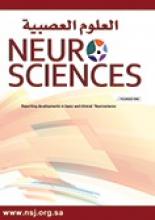Review ArticleReview Article
Open Access
Metabolic and genetic disorders mimicking cerebral palsy
Wejdan S. Hakami, Khaled J. Hundallah and Brahim M. Tabarki
Neurosciences Journal July 2019, 24 (3) 155-163; DOI: https://doi.org/10.17712/nsj.2019.3.20190045
Wejdan S. Hakami
Division of Pediatric Neurology, Department of Pediatrics, Prince Sultan Military Medical City, Riyadh, Kingdom of Saudi Arabia
MDKhaled J. Hundallah
Division of Pediatric Neurology, Department of Pediatrics, Prince Sultan Military Medical City, Riyadh, Kingdom of Saudi Arabia
MDBrahim M. Tabarki
Division of Pediatric Neurology, Department of Pediatrics, Prince Sultan Military Medical City, Riyadh, Kingdom of Saudi Arabia
MD
References
- ↵
- Graham HK,
- Rosenbaum P,
- Paneth N,
- Dan B,
- Lin JP,
- Damiano DL,
- et al.
- ↵
- Colver A,
- Fairhurst C,
- Pharoah PO
- ↵
- Leach EL,
- Shevell M,
- Bowden K,
- Stockler-Ipsiroglu S,
- van Karnebeek CD
- ↵
- Zouvelou V,
- Yubero D,
- Apostolakopoulou L,
- Kokkinou E,
- Bilanakis M,
- Dalivigka Z,
- et al.
- ↵
- Appleton RE,
- Gupta R
- ↵
- Pearson TS,
- Pons R,
- Ghaoui R,
- Sue CM
- Segel R,
- Ben-Pazi H,
- Zeligson S,
- Fatal-Valevski A,
- Aran A,
- Gross-Tsur V,
- et al.
- Takezawa Y,
- Kikuchi A,
- Haginoya K,
- Niihori T,
- Numata-Uematsu Y,
- Inui T,
- et al.
- ↵
- McMichael G,
- Bainbridge MN,
- Haan E,
- Corbett M,
- Gardner A,
- Thompson S,
- et al.
- Carecchio M,
- Mencacci NE
- ↵
- Matthews AM,
- Blydt-Hansen I,
- Al-Jabri B,
- Andersen J,
- Tarailo-Graovac M,
- Price M,
- et al.
- ↵
- Lee RW,
- Poretti A,
- Cohen JS,
- Levey E,
- Gwynn H,
- Johnston MV,
- et al.
- ↵
- Al Salloum AA,
- El Mouzan MI,
- Al Omar AA,
- Al Herbish AS,
- Qurashi MM
- ↵
- Reid SM,
- Dagia CD,
- Ditchfield MR,
- Carlin JB,
- Reddihough DS
- ↵
- Monies D,
- Abouelhoda M,
- AlSayed M,
- Alhassnan Z,
- Alotaibi M,
- Kayyali H,
- et al.
- ↵
- de Souza PVS,
- de Rezende Pinto WBV,
- de Rezende Batistella GN,
- Bortholin T,
- Oliveira ASB
- ↵
- Thabet F,
- Tlili-Graiess K,
- Tabarki B
- ↵
- Bi D,
- Wang H,
- Shang Q,
- Xu Y,
- Wang F,
- Chen M,
- et al.
- ↵
- Wolf B
- ↵
- Jichlinski A,
- Clarke L,
- Whitehead MT,
- Gropman A
- ↵
- Al Mutairi F,
- Alfadhel M,
- Nashabat M,
- El-Hattab AW,
- Ben-Omran T,
- Hertecant J,
- et al.
- Bosley TM,
- Alorainy IA,
- Oystreck DT,
- Hellani AM,
- Seidahmed MZ,
- Osman Mel F,
- et al.
- Van Rappard DF,
- Boelens JJ,
- Wolf NI
- Wiesinger C,
- Eichler FS,
- Berger J
- ↵
- Cho KH,
- Shim SH,
- Kim M
- ↵
- Kulshreshtha D,
- Maurya PK,
- Singh AK,
- Thacker AK
- ↵
- Friedman J,
- Roze E,
- Abdenur JE,
- Chang R,
- Gasperini S,
- Saletti V,
- et al.
- ↵
- AlSubhi S,
- AlShahwan S,
- AlMuhaizae M,
- AlZaidan H,
- Tabarki B
- ↵
- Boy N,
- Mühlhausen C,
- Maier EM,
- Heringer J,
- Assmann B,
- Burgard P,
- et al.
- ↵
- Fons C,
- Campistol J
- ↵
- Molero-Luis M,
- Serrano M,
- O'Callaghan MM,
- Sierra C,
- Pérez-Dueñas B,
- García-Cazorla A,
- et al.
- ↵
- Fu R,
- Chen CJ,
- Jinnah HA
- ↵
- Chang FC,
- Westenberger A,
- Dale RC,
- Smith M,
- Pall HS,
- Perez-Dueñas B,
- et al.
- Suzuki-Muromoto S,
- Wakusawa K,
- Miyabayashi T,
- Sato R,
- Okubo Y,
- Endo W,
- et al.
- McMichael G,
- Haan E,
- Gardner A,
- Yap TY,
- Thompson S,
- Ouvrier R,
- et al.
- ↵
- Pacheva IH,
- Todorov T,
- Ivanov I,
- Tartova D,
- Gaberova K,
- Todorova A,
- et al.
- ↵
- Méneret A,
- Roze E
- ↵
- Rothblum-Oviatt C,
- Wright J,
- Lefton-Greif MA,
- McGrath-Morrow SA,
- Crawford TO,
- Lederman HM
- ↵
- Chen YC,
- Liang WC,
- Su YN,
- Jong YJ
- ↵
- Sullivan R,
- Yau WY,
- O'Connor E,
- Houlden H
- ↵
- Kumar S,
- Singh D
- ↵
- El-Hattab AW,
- Scaglia F
- Vafaee A,
- Baghdadi T,
- Norouzzadeh S
- Suzuki R,
- Tanaka A,
- Matsui T,
- Gunji T,
- Tohyama J,
- Nairita A,
- et al.
- ↵
- Regier DS,
- Proia RL,
- D'Azzo A,
- Tifft CJ
- ↵
- McMillan HJ,
- Holahan AL,
- Richer J
In this issue
Metabolic and genetic disorders mimicking cerebral palsy
Wejdan S. Hakami, Khaled J. Hundallah, Brahim M. Tabarki
Neurosciences Journal Jul 2019, 24 (3) 155-163; DOI: 10.17712/nsj.2019.3.20190045
Jump to section
Related Articles
- No related articles found.
Cited By...
- No citing articles found.





